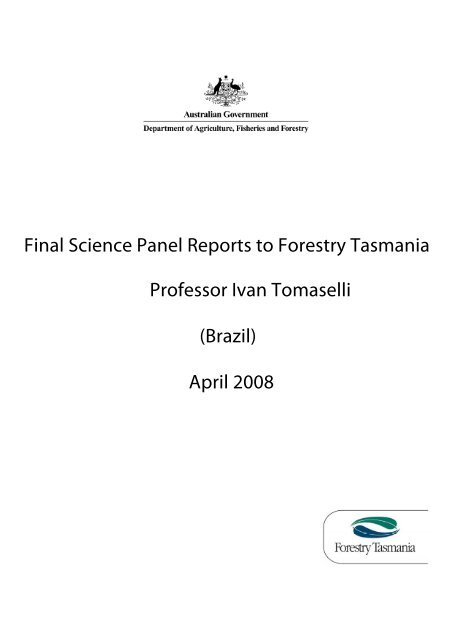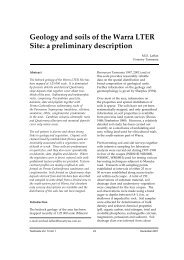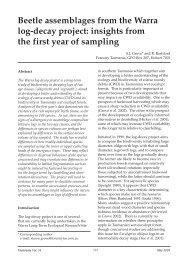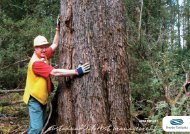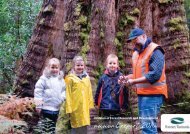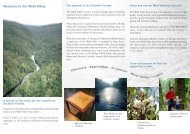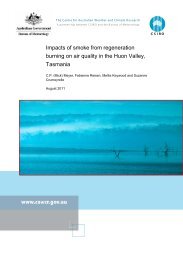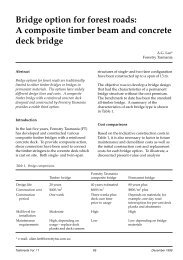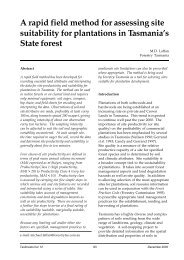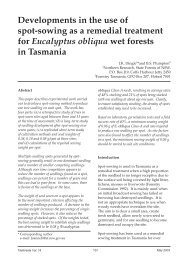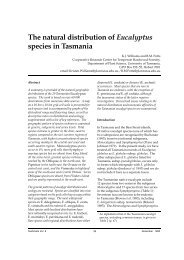Professor Ivan Tomaselli Report - Forestry Tasmania
Professor Ivan Tomaselli Report - Forestry Tasmania
Professor Ivan Tomaselli Report - Forestry Tasmania
You also want an ePaper? Increase the reach of your titles
YUMPU automatically turns print PDFs into web optimized ePapers that Google loves.
Final Science Panel <strong>Report</strong>s to <strong>Forestry</strong> <strong>Tasmania</strong><br />
<strong>Professor</strong> <strong>Ivan</strong> <strong>Tomaselli</strong><br />
(Brazil)<br />
April 2008
FORESTRY TASMANIA<br />
COMMENTS ON THE PROGRAM OF REDUCED<br />
RELIANCE ON CLEARFELLING IN OLD GROWTH FORESTS<br />
AND OTHER ASPECTS<br />
<strong>Report</strong> prepared by<br />
<strong>Ivan</strong> <strong>Tomaselli</strong><br />
STCP Engenharia de Projetos<br />
Curitiba, Brazil<br />
May 2008
CONTENTS<br />
Page<br />
1- INTRODUCTION……………………………………………………………3<br />
2- UNDERSTANDING PROBLEMS AND DEFINING CONCEPTS………3<br />
3- NEW SILVICULTURE APPLIED TO OLD GROWTH FORESTS………5<br />
4- MANAGEMENT OF REGROWTH FORESTS ……………………….….5<br />
5- FOREST PLANTATIONS …………………………………………….……10<br />
6- BIOFUELS IN HARVESTING AREAS……………………………………11<br />
7- OLD FORESTS NEW MANAGEMENT CONFERENCE……………….12<br />
8- CONCLUSIONS AND RECOMMENDATIONS……………….…………12<br />
Acknowledgments<br />
ANNEX- Itinerary of the Science Panel Members First Mission<br />
2 2
1- INTRODUCTON<br />
During the first week of September 2007 the consultant visited <strong>Tasmania</strong> as part of a<br />
scientific panel of experts, in forest conservation and forest industry activity, convened to<br />
provide advice to <strong>Forestry</strong> <strong>Tasmania</strong> and its governing Board, on the program of reduced<br />
reliance on clearfelling in oldgrowth forests.<br />
The scientific panel was created by <strong>Forestry</strong> <strong>Tasmania</strong> as part of the efforts of the company<br />
to improve forest practices following <strong>Tasmania</strong>n Government’s request for advice, in<br />
September 2003, on the feasibility of a phase out clearfelling within oldgrowth forests on<br />
public land by 2010. The request takes into consideration an area of 60,000 ha of oldgrowth<br />
forests where clearfelling would be the traditional silviculture, out of a total area of 1.24<br />
million ha in the state.<br />
During the week in <strong>Tasmania</strong> the consultant worked in close cooperation with other<br />
members of the Panel (<strong>Professor</strong> Jürgen Bauhus and Dr. Thomas Spies) and received<br />
relevant information on implementation of variable retention (VR) silviculture and the<br />
research program at the Warra Long-Term Ecological Research (LTER) site as well as<br />
silvicultural and ecological research on operational VR coupes. Also during the week it was<br />
possible to review several background documents made available.<br />
As part of the program, on September 4 th the panel visited the Styx Valley, including<br />
oldgrowth and older regrowth forests, and discussed harvesting operations and fire<br />
management in recently harvested VR coupes. On September 6 th the panel visited the<br />
Southern Forests and discussed fire ecology, silviculture, regrowth thinning and industrial<br />
operations (Southwood). During both field visits the consultant profited from the<br />
discussions held with foresters and other professionals directly involved in the field<br />
operations.<br />
In February 2008, between 17 th and 22 nd , the consultant made a second visit to <strong>Tasmania</strong>.<br />
During the second visit the consultant participated and made a presentation at the Old<br />
Forest New Management Conference held in Hobart between the 17 th and 21 st . The<br />
scientific conference was organized by <strong>Forestry</strong> <strong>Tasmania</strong> together with the Cooperative<br />
Research Centre for <strong>Forestry</strong> and the International Union of Forest Research Organisations.<br />
Taking advantage of the visit the Science Panel had a meeting with FT Board on the 22 nd .<br />
This document presents comments on the issues found to be relevant to <strong>Forestry</strong> <strong>Tasmania</strong>,<br />
and is largely based on the discussions held and impressions collected during the one week<br />
visit held in September 2007, and participation in the Conference. As time was limited for<br />
the collection and analysis of information, and also for the preparation of the report, this<br />
document should be taken as a summary of impressions rather than a scientific or technical<br />
report.<br />
3 3
2- UNDERSTANDING THE PROBLEM AND DEFINING CONCEPTS<br />
<strong>Forestry</strong> <strong>Tasmania</strong> is a timberland management company, having its business largely, but<br />
not exclusively, associated with timber trade in the domestic and international market. In<br />
managing the State Forests the company focus is not just on the production of goods but<br />
also on services. Some of the goods and services are traded in the local and international<br />
markets, while others are not exchanged in the market but nevertheless are important as<br />
they affect social welfare.<br />
In general terms it can be said that production and consumption of goods and services<br />
create externalities, which can be defined as changes in a third party’s welfare (at local or<br />
global level). When these result in an increase in the third party’s welfare, it is said that a<br />
positive externality or external benefit has been generated. When there is a decrease in the<br />
third party’s welfare, it is said that a negative externality or external cost has been<br />
produced.<br />
<strong>Forestry</strong> <strong>Tasmania</strong> produces timber from managed forests and is paid for it. The company<br />
operations and the timber produced generate employment and revenue to the <strong>Tasmania</strong>n<br />
population, and these are examples of positive externalities.<br />
On the other hand by managing forests sustainably, especially when managing natural<br />
forests, <strong>Forestry</strong> <strong>Tasmania</strong> also contributes to soil and water conservation, and this creates<br />
local benefits by increasing or maintaining land productivity, water bodies and production<br />
of goods and services such as clean water for domestic or industrial consumption. There are<br />
also some other local benefits, such as the aesthetic values that enhance tourism, that have<br />
positive local social and economic impacts.<br />
Furthermore <strong>Forestry</strong> <strong>Tasmania</strong> operations also create conditions to increase carbon<br />
sequestration and storage, and contribute to biodiversity preservation. These are positive<br />
externalities that affect the welfare on a global scale. Carbon sequestration or storage<br />
services are provided by old growth natural forests as well as the other types of forest, such<br />
as plantations and regrowth, regardless of the site’s particular features. On the other hand<br />
biodiversity preservation, to be effective, requires almost pristine forests in relatively large<br />
areas to assure the full benefits of their preservation over time. This might not be the case<br />
for all the forest areas managed by <strong>Forestry</strong> <strong>Tasmania</strong>, but certainly there are extensive and<br />
representative areas that the company maintains that make an important contribution to<br />
biodiversity conservation.<br />
The perception of the consultant is that the efforts and investments made by <strong>Forestry</strong><br />
<strong>Tasmania</strong> to generate local and global positive externalities resulting from services<br />
provided by well managed forests are not marketed and the company is not compensated<br />
for the services provided.<br />
It should be recognized that this is not a particularity of <strong>Forestry</strong> <strong>Tasmania</strong>. In dealing with<br />
biodiversity, for instance, although most of the goods produced based on genetic resources<br />
are private and their prices reflect their relative scarcity, the genetic resources that allowed<br />
4 4
them to be produced usually do not have market prices and are externalities for which the<br />
landowner, in whose lands the resources are found, is rarely compensated.<br />
In general terms the concept is that forest management and operations in production forests<br />
can be continuously improved. The review of documents, field observations and the<br />
discussions held during the visit clearly indicated that <strong>Forestry</strong> <strong>Tasmania</strong> has continuously<br />
invested to improve forest management practices, and this will contribute to further<br />
mitigate negative externalities and enhance positive externalities over time.<br />
In spite of its efforts it seems that <strong>Forestry</strong> <strong>Tasmania</strong> has not been fully recognized for the<br />
services provided to the society and for its contribution to improve social welfare at local<br />
and global levels. In fact the company has been criticized and has been forced to increase<br />
investments in research and reduce wood removals. So far wood is the only significant<br />
good that the company trades in the market and reduction on wood removals above certain<br />
levels can put at risk the economic sustainability of the business.<br />
In reality the pressure on the forest industry has been a global trend. It is growing over time<br />
in all parts of the world, especially for industry operating in natural forests. The forest<br />
industry has been asked to increase its contribution to welfare at local and global levels, and<br />
this is continuously reducing profitability, and this tends to make wood less competitive in<br />
the market.<br />
<strong>Forestry</strong> <strong>Tasmania</strong> manages State Forests, including natural forests with important aesthetic<br />
and cultural values for the local society. These aspects, combined with the fact that local<br />
society has achieved a high cultural, socio and economic development stage, tend to<br />
increase the demand for the contribution to the local and global social welfare. Within this<br />
context the <strong>Forestry</strong> <strong>Tasmania</strong> Board seeks to respond to society demands, while at the<br />
same time find ways to mitigate impacts of new demands on the business, and keep<br />
operations profitable to ensure the company’s sustainability.<br />
3- NEW SILVICULTURE APPLIED TO OLD GROWTH FORESTS<br />
The new silviculture applied by <strong>Forestry</strong> <strong>Tasmania</strong> to manage old growth forests was<br />
presented to the consultant based on documents, presentations made by the staff and field<br />
visits. The new silviculture is in response to the local society demands and, at the same<br />
time, maintains timber production in the old growth forests.<br />
In developing alternatives to the clearfell, burn and sow (CBS) practice in old growth<br />
forests, <strong>Forestry</strong> <strong>Tasmania</strong> has considered a set of performance criteria agreed with the<br />
Government of <strong>Tasmania</strong> when the request for advice on management of old growth forest<br />
was made. The set of criteria included the following:<br />
i. Maintenance of a minimum supply level of 300 thousand cubic meters per year of<br />
high quality eucalypt veneer and sawlog material;<br />
ii.<br />
Maintenance of contracted commitments;<br />
5 5
iii.<br />
iv.<br />
Maintenance and enhancement of occupational health and safety in forest<br />
operations;<br />
Safe processing and removal of forest harvesting residues;<br />
v. Regeneration which meets stocking standards for sustainable forest management;<br />
vi.<br />
Maintenance of jobs of <strong>Tasmania</strong>n timber workers.<br />
Among the alternatives to clearfell, burn and sow (CBS) tested by <strong>Forestry</strong> <strong>Tasmania</strong> are<br />
CBS with understorey islands, stripfell, dispersed retention, aggregated retention and single<br />
tree/ small group selection. During the visit particular attention was given to aggregated<br />
retention coupes (ARN), although other silvicultural systems were also discussed and<br />
visited in the field.<br />
The VR coupes visited during the two field trips had areas of around 20 ha. The coupes<br />
were felled leaving undisturbed forest patches of around 1-2 hectares within the harvested<br />
area for the purposes of maintaining habitat for biodiversity, to ensure seed supply for<br />
regeneration and also for aesthetic reasons. Retention varied between 20-30% of the coupe<br />
area, and this means that in principle the wood removals are lower by the same proportion.<br />
From the observations made it seems that the VR coupes represent an option to demonstrate<br />
to the public that <strong>Forestry</strong> <strong>Tasmania</strong> is making efforts to reduce the impacts of harvesting in<br />
old growth forests. The new system can, and will be improved over time, as experience<br />
will be gained on different aspects involved, especially on fire management. In developing<br />
the new system <strong>Forestry</strong> <strong>Tasmania</strong> might also want to consider the potential to develop<br />
alternatives to make gains by taking into account other aspects, especially that relate to the<br />
large quantity of biomass in left on the ground.<br />
Based on information made available and observations during the field visits, between 200<br />
to 300 tonnes of biomass per hectare (some information refers up to 500 tonnes) is left on<br />
the ground when harvesting is completed. The reasons mentioned to justify this practice<br />
were:<br />
i. The quality of the material (wood) is not adequate for industrial consumption;<br />
ii.<br />
iii.<br />
iv.<br />
There is no other economic/ market alternatives (such as fuel wood);<br />
The biomass left in harvested areas is important to produce an ash bed and facilitate<br />
regeneration;<br />
Biomass, especially coarse woody debris, left on the ground plays an important role<br />
in the maintenance of biodiversity.<br />
Discussions on the amount of the wood residues left on the ground during harvesting<br />
operations are not a new issue for <strong>Forestry</strong> <strong>Tasmania</strong>. In spite of the fact that several studies<br />
6 6
were carried out in the past (CSIRO studied the option of the use of the material for energy<br />
generation), it seems that this matter should be revisited as the volumes left are very high<br />
and new opportunities/ options should be identified and adopted.<br />
In doing so a broader perspective should be considered and this could be done by revisiting/<br />
improving information on several issues, in order to critically analyze the following<br />
aspects:<br />
i. Quantity and quality of residues left after harvesting by forest type (this should<br />
cover harvesting operations in old growth forests and also other forest types);<br />
ii.<br />
iii.<br />
iv.<br />
Products standards (particularly products for fiber) and implications on the sales<br />
contracts;<br />
Ways to combine harvesting of sawlogs, pulpwood and fuel wood in order to<br />
minimize costs, and at the same time avoid to returning to the coupe (that could<br />
increase environmental impacts due to soil disturbance);<br />
Impact of biomass left in the ground on economic, environmental and public<br />
perception aspects, particularly on forest regeneration, fire management<br />
(especially when burning VR coupes) and biodiversity.<br />
The economic equation and other aspects involved in a feasibility study involving<br />
collection and transport of harvesting residues for power generation is complex as other<br />
aspects, not directly involved in the actual operation, might be important. An example of<br />
these other aspects is the impact that removal of wood residues may have on fire break<br />
costs and fire management.<br />
At the moment the area of fire breaks in VR coupes is quite significant (around 30 percent<br />
of the total area), and the costs involved (especially using excavators) is probably quite<br />
high. A reduction on the wood residues might facilitate fire management, and as a result the<br />
fire break width could, in principle, be reduced with positive impacts on costs.<br />
Reductions in costs are always desirable, but there are other aspects that might be important<br />
to consider in dealing with increasing removals from harvesting areas. Some of the aspects<br />
might have a positive contribution, while others not.<br />
For instance if the reduction in the amount of biomass left on the ground facilitates fire<br />
management, patches left in VR coupes can be better protected from fire. As a result, public<br />
perception of advances made by <strong>Forestry</strong> <strong>Tasmania</strong> by the adoption of VR will be<br />
improved (a positive contribution). On the other hand, the impacts on regeneration should<br />
also be measured, and to increase the removals might have a negative impact.<br />
In spite of the fact that seems to be important to assess the real impact resulting from<br />
increased wood removals on regeneration and biodiversity, it seems logical that higher<br />
levels of removal can be achieved without having significant collateral impacts.<br />
7 7
The positive economic impact of increasing removals will be important to offset the<br />
reductions on harvesting area (and consequently in volume and revenues) resulting from the<br />
adoption of the new silviculture, and therefore the issue deserves to be fully investigated.<br />
The investigation should cover, among others, the following relevant steps/ activities:<br />
i. To improve knowledge on the material available<br />
Taking into consideration the reported amount of wood left on the ground (quite<br />
significant), and also from field observations, it seems to be reasonable to assess the<br />
quality of the material left on the ground. The investigation should cover the criteria<br />
used in defining material as appropriate for pulp wood, based on the product<br />
standard adopted in the sales agreement;<br />
ii.<br />
To define the new level of removal and review product standard<br />
Information obtained from the assessment of the product quality will inform the<br />
possibility of increasing removals based on the current uses of the wood,<br />
particularly the pulp wood. The objective would be to create elements for a possible<br />
discussion and review of standards established in the sales agreement.<br />
iii.<br />
To assess the feasibility of harvesting wood for energy<br />
A large portion of the biomass left in the ground at the moment would not be<br />
adequate for pulp, but can be used as fuel wood. An investigation on the feasibility<br />
of removing this material (basically harvesting and transport costs) is needed as a<br />
first stage. The study should consider different levels of removal and also test<br />
harvesting alternatives. The ultimate objective is to estimate costs to analyze the<br />
attractiveness of investments in energy generation based on biomass.<br />
iv.<br />
Other aspects involved<br />
If harvesting of fuel wood is considered a feasible option from the economic point<br />
of view, a further study should be carried out on other implications. As previously<br />
mentioned, removing more biomass from the coupes might have negative<br />
implications for soil, regeneration and biodiversity, but it can also contribute to<br />
reducing the width of fire breaks (and therefore reduce costs making fuelwood<br />
harvesting more attractive).<br />
Also by reducing biomass on the ground fire management is expected to be<br />
facilitated and this may avoid fire damage to the forest patches retained after VR<br />
harvesting. This should improve biodiversity conservation and improve public<br />
perception on advances made by <strong>Forestry</strong> <strong>Tasmania</strong> in adopting the new<br />
silviculture.<br />
Besides the above listed steps there are also other options that <strong>Forestry</strong> <strong>Tasmania</strong> might<br />
want to test in VR coupes. It seems for instance that the use of retained ‘peninsulas’ could<br />
be a better option than the retention of isolated forest patches inside the harvested area.<br />
8 8
Increased use of peninsulas would drive the silviculture system towards a similar condition<br />
as the stripfell treatment, but design of the peninsulas should be changed to improve<br />
aesthetic values. On the other hand peninsulas might create difficulties for harvesting<br />
operations (creating additional costs) and the risk for workers needs to be better assessed.<br />
It is important to have in mind that a few years more of field observations will be necessary<br />
to have scientific evidence of other potential benefits from VR silviculture for biodiversity,<br />
soil protection and seed supply for regeneration of the harvested areas. The perception of<br />
the consultant is that gains in biodiversity by using the new silvicultural system might be<br />
important when analyzing a micro location (retained areas within the coupe and for coarse<br />
woody debris left in the ground). However, given the size of the operations and the long<br />
forest rotations adopted, its differential contribution over time in terms of maintenance of<br />
the biodiversity of the <strong>Tasmania</strong> forests as a whole is most probably negligible.<br />
It might not desirable for <strong>Forestry</strong> <strong>Tasmania</strong> to enter into this discussion. The local gains in<br />
biodiversity of the new system, as compared with the traditional CBS system, can be<br />
important in dealing with public perception, and this is what needs to be explored by<br />
<strong>Forestry</strong> <strong>Tasmania</strong>. Also the variable retention system seems to be an adequate alternative<br />
to the traditional CBS silvicultural system when dealing with aesthetic values, which has a<br />
strong impact on public perception, and this is important to maintain <strong>Forestry</strong> <strong>Tasmania</strong>’s<br />
operations at the moment.<br />
4- MANAGEMENT OF REGROWTH FORESTS<br />
Regrowth forests are currently managed on relatively long rotations (80 – 100 years). Based<br />
on the discussions, the reasons for such long rotations are associated with economic and<br />
environment aspects, but no clear evidence to support these were made available.<br />
Longer rotations allow a forest area to be left undisturbed for a longer period, and this<br />
probably creates environment benefits. On the other hand longer rotations allow larger logs<br />
for the industry, and this is more a tradition in the local forest industry than a technical and<br />
economic matter.<br />
Observation made in regrowth forests recently thinned (with an approximate age of 40<br />
years) indicate that most of the logs could be used for sawnwood and veneer production<br />
using current available processing technology, and most probably would benefit the<br />
industry. Practically all logs used in the Southwood industrial complex (involving a<br />
sawmill and a veneer mill) are small to medium diameter logs that could be produced in<br />
rotations of 50 years (or less).<br />
<strong>Forestry</strong> <strong>Tasmania</strong> has probably already studied the economic implications of reducing the<br />
management rotation of regrowth forests, but it seems that for several reasons this option<br />
has not been fully explored. In principle, in economic terms, the reduction in rotation would<br />
be a first alternative to be explored to maintain wood output at current levels if harvesting<br />
in oldgrowth forests has to be reduced.<br />
9 9
<strong>Forestry</strong> <strong>Tasmania</strong> might want to revisit this matter and in doing so the following steps and<br />
activities should be considered:<br />
i. Evaluate the economic impact on wood production<br />
Existing information should be valuable to develop a model to assess the impact of<br />
shorter rotations for the company business. Aspects to be covered are yields,<br />
products to be made available to market, silviculture costs, harvesting costs and<br />
other costs involved under different rotations and management treatments. The<br />
ultimate objective is to analyze returns considering shorter cutting cycles and using<br />
different management systems.<br />
ii.<br />
Assess market implications<br />
Processors will react to the new option (shorter rotation and smaller diameter logs),<br />
and will tend to seek compensations (via lower prices). <strong>Forestry</strong> <strong>Tasmania</strong> should<br />
not enter into this discussion without a full understanding of the reasons behind the<br />
market reaction, include cultural aspects that may be based on perceptions and<br />
unsound technical information.<br />
The reduction of the rotation can affect wood quality but, within certain rotation<br />
limits, is not expected to be as significant as one would first expect. The processing<br />
industry will probably use arguments based on comparisons made between the<br />
traditional raw material (from old growth forests or from long rotation regrowth<br />
forests) and wood from growing plantation timber (produced in very short rotations<br />
(such as 15 years), but this is not valid when dealing with 40-60 years rotation.<br />
Therefore it will be important for <strong>Forestry</strong> <strong>Tasmania</strong> to have a sound technical basis<br />
to support the discussion, and this includes not just the implications for wood<br />
properties, but also the implications for the industrial process, for production costs<br />
and in the end-product properties and performance. Industrial trials using the new<br />
material will be required to gather this information.<br />
iii.<br />
Evaluate environmental and other aspects<br />
The reduction of the rotation in regrowth forest can have environmental<br />
implications, and also tends to create an adverse public perception. Again in this<br />
case <strong>Forestry</strong> <strong>Tasmania</strong> should gather sound scientific evidence on the<br />
environmental impacts to serve as a basis for discussions.<br />
iv.<br />
Compare with other alternatives<br />
So far the alternative to mitigate impacts of reduction in volumes due to limitations<br />
on harvesting old growth forests is to expand plantations (as proposed in the<br />
scenarios analyzed by <strong>Forestry</strong> <strong>Tasmania</strong> for the Government of <strong>Tasmania</strong>).<br />
Reduction in the rotation of the regrowth forests is an alternative to the plantations,<br />
and therefore it is important to compare the two options.<br />
10 1
The comparison between adopting a shorter rotation for regrowth forests and<br />
plantations should not be based only on financial and economic terms. Other issues<br />
such as differences in wood properties, market implications, environmental impacts<br />
and public perception are also of outstanding importance.<br />
5- FOREST PLANTATIONS<br />
The adoption of a shorter rotation for regrowth forest does not exclude the possibility of<br />
investments in plantations. Plantations will be important to produce low cost fiber and also<br />
lower cost solid wood logs for certain uses. This is a worldwide trend that can not be<br />
neglected in dealing with investments in forests. <strong>Forestry</strong> <strong>Tasmania</strong> should consider<br />
possibilities to invest in alternative plantation management options.<br />
One option to be considered is to focus on plantations that maximize solid wood log<br />
production. Experience gained in other countries in dealing with eucalyptus plantations<br />
indicate that using less trees per hectare (as few as 500), and intensive management can<br />
reduce the rotation and increase average diameter of the trees, producing logs of higher<br />
value. Even if stand volume is reduced, this results in positive impacts on the economic<br />
returns.<br />
Wood produced in intensively managed fast growing plantations has a lower density, but<br />
pruned logs from these plantations has been found to be a good alternative for the<br />
production of plywood, mouldings, furniture components and other value added products.<br />
6- BIOFUELS IN HARVESTING AREAS<br />
As previously discussed, biomass for energy generation is an alternative that should be<br />
further studied. Large volumes are left in coupes when harvesting old growth forests, but<br />
volumes are also significant when thinning regrowth forests areas. As a matter of fact this<br />
issue has been under discussion for quite a long time, and significant amount of information<br />
on the impacts of increasing the removals is available in the CSIRO report submitted to<br />
<strong>Forestry</strong> <strong>Tasmania</strong> in May 2002.<br />
The CSIRO report confirms the observations made by the consultant on the volume<br />
available at the harvesting areas. The report has a strong focus on old growth forests and<br />
the potential risks associated with impacts on soil and biodiversity. Particular attention was<br />
given, for example, on the role of coarse woody debris.<br />
It seems to be important to revisit the issue, and consider implications in a broader<br />
perspective (as earlier suggested in this report) and covering in more detail the financial and<br />
economic aspects and their implications on forest operations.<br />
For instance, the volume of biomass left on the ground when harvesting old growth forests<br />
is significant, but the area harvested annually in this type of forest is relatively small and<br />
will tend to decrease in the future. Investing in energy generation based on biomass is a<br />
long term investment and therefore it is important to ensure that supply will be maintained<br />
11 1
over a longer time. Therefore it is quite important to consider supply from other areas<br />
(particularly regrowth forests).<br />
Besides the fact that the areas of available regrowth forests are larger (and therefore<br />
represents a major potential), it seems that the operations involved in harvesting biomass<br />
for energy from these areas would be easier. During the field visit it was observed that in<br />
recently thinned regrowth forests large volumes of biomass are concentrated on timber<br />
landings, and this means that the material is easily accessible, can be locally processed and<br />
transported to a power plant. In principle this indicates that fuelwood produced from<br />
biomass left in thinned regrowth forests would have a lower cost.<br />
In spite of the large quantities available and indications that generation of energy from<br />
biomass is an option, the decision will largely depend on the economics of the operation. In<br />
places such as <strong>Tasmania</strong>, where energy costs are relatively low (and a surplus exists), it<br />
might be difficult to make generation of energy based on biomass a feasible option, unless<br />
incentives are made available or new and more efficient technologies are developed.<br />
7- OLD FORESTS NEW MANAGEMENT CONFERENCE<br />
The Conference organized by FT together with the Cooperative Research Centre for<br />
<strong>Forestry</strong> and the International Union of Forest Research Organisations and held in Hobart<br />
in February brought together national and international researchers from a range of<br />
disciplines, and focussed mainly on sustainable management and use of old-growth forests.<br />
At the Conference the consultant made a presentation on the option of combining oldgrowth,<br />
regrowth and plantation timber to promote sustainable trade, a trading system that<br />
does not harm the environment or deteriorate social conditions while promoting economical<br />
growth.<br />
At the meeting held on February 22 nd with FT board the Panel members expressed their<br />
views on the Conference. The general impression was that the Conference was very well<br />
organized, and presentations provided a good summary of the ‘State of the Art’ on<br />
management of old growth forests and on benefits of VR in addressing biodiversity issues.<br />
The Panel members also considered that the Conference helped to identify several aspects<br />
that can drive the FT research program in the future. It was noticed, for example, that it<br />
might be important to increase the knowledge on the importance of old growth forests for<br />
carbon sequestration and water conservation.<br />
The consultant suggested that FT should consider global perspectives and global<br />
interactions when making decisions related to forest management in <strong>Tasmania</strong>. It should<br />
take in account that global wood supply is limited and consumption is expected to continue<br />
increase for the next decades. If wood supply from <strong>Tasmania</strong> is, for some reason<br />
significantly reduced in the future, other sources will need to be identified and this can have<br />
implications in the sustainability of forests in other parts of the world.<br />
8- CONCLUSIONS AND RECOMMENDATIONS<br />
12 1
All over the world the forest industry has been asked to increase its contribution to welfare<br />
at local and global levels. <strong>Forestry</strong> <strong>Tasmania</strong>’s efforts to respond to the society demands,<br />
while at the same time finding ways to mitigate impacts of the new demands on the<br />
business, are indeed important to maintain operations and ensure the company’s<br />
sustainability.<br />
<strong>Tasmania</strong> <strong>Forestry</strong> has been working to respond to the society demands, and has effectively<br />
contributed to the request for advice made by the Government of <strong>Tasmania</strong> to find<br />
alternatives to clearfelling for management of old growth forests for timber production.<br />
Considering that <strong>Forestry</strong> <strong>Tasmania</strong> is a company, the investments made on research and<br />
development are high. Although results are still not conclusive, there are indications that it<br />
is possible to adopt new alternatives to mitigate impacts of harvesting in old growth forests,<br />
and accommodate to some extent, public concerns.<br />
Efficiency and effectiveness of the actions taken are still to be measured, nevertheless it<br />
seems that it will be difficult (and costly) to convince society that harvesting operations in<br />
old growth can be maintained without creating negative externalities, and that it will not<br />
have a significant effect on local and global welfare.<br />
Being pragmatic on this issue: in the best situation <strong>Forestry</strong> <strong>Tasmania</strong> will be able to<br />
postpone the decision on banning harvesting in old growth forests, but will need to accept<br />
the fact that costs will continue to increase over time. Based on this premise it should<br />
consider the following aspects in defining a long term strategy:<br />
i. Continue the current research program focusing on extending life of operations<br />
in old growth forests;<br />
ii.<br />
iii.<br />
iv.<br />
Create a more consistent strategy to improve communication with society,<br />
focusing on gains (positive externalities) rather than problems and impacts;<br />
Carry out studies to assess the feasibility of increasing removals when<br />
harvesting old growth forest. This should cover and in depth analysis of biomass<br />
quality to assess possibilities for increased volumes of pulp wood harvesting<br />
(including the need to change standards in sales contracts) and the option of<br />
harvesting biomass for energy;<br />
Consider the feasibility of also harvesting biomass for energy from other<br />
operations, particularly from thinning operations in regrowth forests;<br />
v. Study alternatives and the implications of adopting a shorter rotation in<br />
regrowth forests as a potential alternative (or complementary) strategy to the<br />
plantations within the scenarios presented to the Government of <strong>Tasmania</strong>;<br />
vi.<br />
Analyze the option to invest in plantations managed to increase the production<br />
of logs for the solid wood products industry;<br />
13 1
vii.<br />
Work together with the local timber industry, and seek the support of the<br />
government, to change local culture and invest in technology to process smaller<br />
diameter logs from shorter rotation regrowth forests and also from plantations.<br />
There is no doubt that wood produced from the old growth forest is special. On the other<br />
hand old growth forest will not be the main supply in the future. The future supply will<br />
come from regrowth forests and plantations, and therefore investments to increase<br />
competitiveness and ensure the sustainability of the operations should be gradually moved<br />
in this direction.<br />
This does not means that <strong>Forestry</strong> <strong>Tasmania</strong> should radically change, and have a new<br />
approach in the ongoing research program or in the current forest operations. The<br />
investments made in the research program are of outstanding importance and should be<br />
kept to help extend time over which old growth forests can be harvested. However the<br />
Board needs to have in mind that times will change, and that investments will need to be<br />
made in areas that can create the best competitive advantages to maintain future operations.<br />
Furthermore, in defining its strategy, <strong>Forestry</strong> <strong>Tasmania</strong> might also want to consider global<br />
perspectives and the possible impacts of its decisions on forests in other parts of the world.<br />
Acknowledgments:<br />
The consultant would like to acknowledge all support received from the Forest <strong>Tasmania</strong><br />
staff, especially from John Hickey for the visit coordination. The effort of the staff to<br />
summarize, and make available relevant information over such a short time, was of<br />
outstanding importance to facilitate the understanding of the problem involved.<br />
14 1
ANNNEX<br />
ITINERARY OF THE VR SCIENCE PANEL MEMBERS<br />
(August 31 to September 8, 2007)<br />
September 3, Monday<br />
9:00- Briefing on <strong>Forestry</strong> <strong>Tasmania</strong> transition to mixed silviculture<br />
10:00 - Overview of research program at Warra silvilcultural systems trial<br />
12:00- Presentation by <strong>Ivan</strong> <strong>Tomaselli</strong>: Bioenergy Opportunities: Overview<br />
and Trends in Brazil;<br />
13:00- Discussions<br />
September 4, Tuesday<br />
8:00- Travel to Styx Valley/ field visits<br />
10:00- TN065B- CBS/ Overview<br />
10:30- TN063D- 50 years old regrowth<br />
11:00- SX020A- VR harvesting<br />
12:00- SX019E TCFA<br />
12:30- SX018E VR burning feasibility<br />
13:30- Big Tree Reserve<br />
14:30- Tim Shea Landscape<br />
18:00- Arrive in Hobart<br />
September 5, Wednesday<br />
9:00- Silvicultural and ecological research for operational VR coupes<br />
10:00- CRC- OFNM Conference Media Announcement (at CRC)<br />
12:00- Presentation by Tomas Spies: Comparison of Oldgrowth Management<br />
approaches in Pacific North-West and Australia<br />
13:00- Reading documents/ discussions<br />
September 6, Thursday<br />
8:00- Travel to Southern Forests/ field visits<br />
10:00- Fire ecology/ Warra LTER site, silvicultural trial/ regrowth thinning<br />
14:00- Southern site: merchandiser yard, regrowth sawmill, rotary-peeled<br />
veneer mill.<br />
18:00- Arrive in Hobart<br />
September 7, Friday<br />
8:30- Reading/ preparation of report<br />
13:00- Public Lunchtime Talk : Future markets for plantation wood:<br />
experiences from Brazil (by <strong>Ivan</strong> <strong>Tomaselli</strong>)<br />
14:30- Presentation of preliminary ideas to FT<br />
15 1


